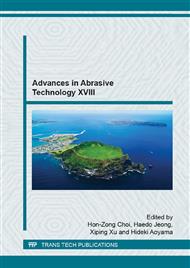p.317
p.321
p.327
p.333
p.338
p.343
p.350
p.359
p.365
Numerical Analysis of Slurry Flow and Contact Pressure in CMP Considering the Effects of Retaining Ring
Abstract:
Retaining ring which keeps the wafer in place is an essential component in chemical mechanical polishing. Meanwhile, it helps to reduce the edge exclusion region where the material removal rate deviates significantly from that of the central region of the wafer. However, it may increase the slurry flow resistance and hence decrease the slurry flow rate. For properly designing a retaining ring of reasonable structure, the effects of retaining ring on slurry flow and contact pressure distribution in CMP process are analyzed by the mixed elastohydrodynamic lubrication model. It is found that the slurry flow is sensitive to the protrusion height of retaining ring used in the first generation carrier. The same as the first generation carrier, the slurry flow is obviously reduced with increasing pressure acting on the retaining ring in the second generation carrier. In addition, the floating retaining ring used in the second generation CMP carrier has better performance and is more controllable than the fixed retaining ring used in the first generation CMP carrier.
Info:
Periodical:
Pages:
338-342
Citation:
Online since:
January 2016
Authors:
Price:
Сopyright:
© 2016 Trans Tech Publications Ltd. All Rights Reserved
Share:
Citation:


